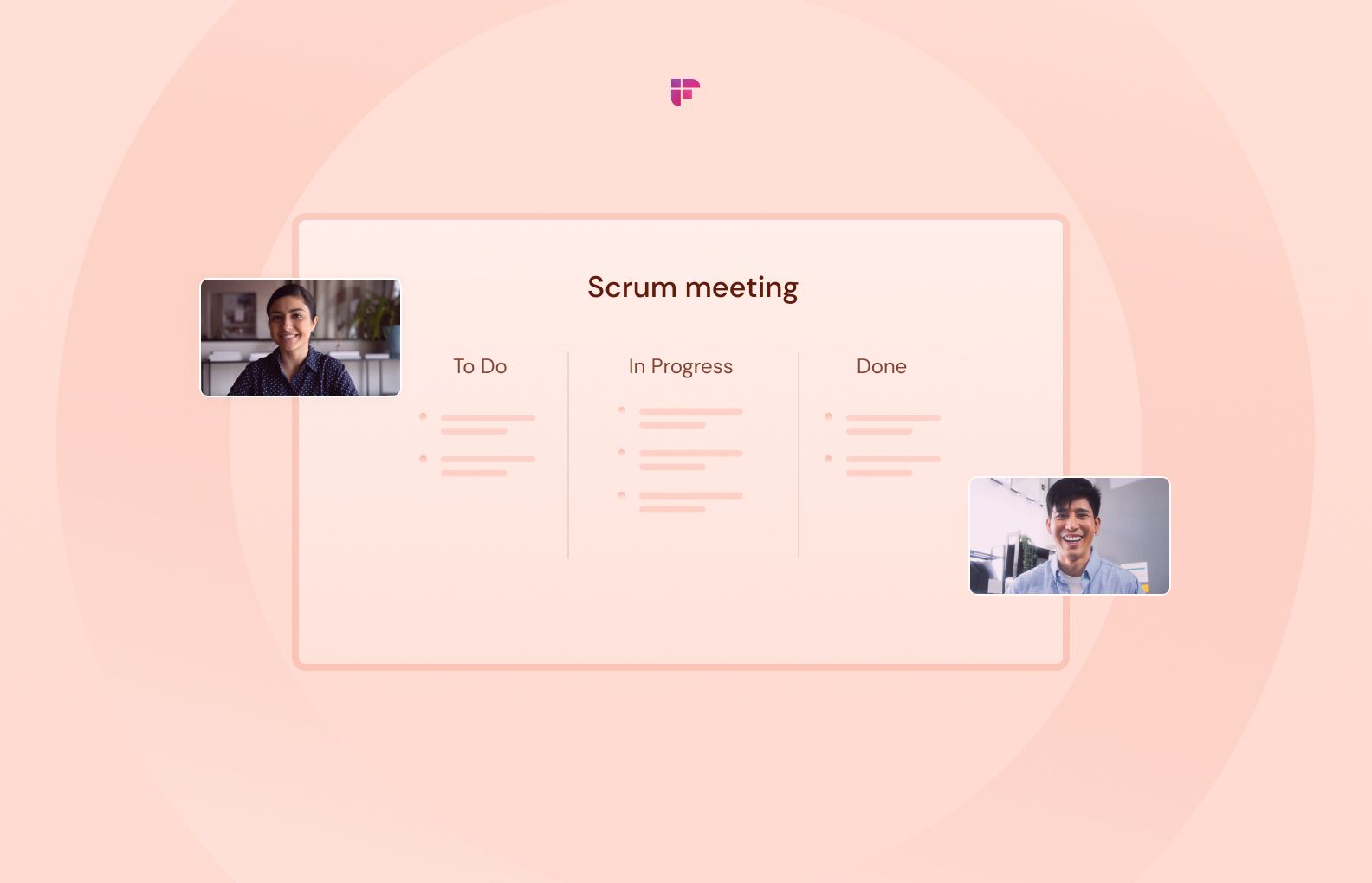If you're reading this blog, chances are you're already familiar with Scrum meetings. You may have attended one, heard the phrase thrown around, or simply have a curiosity about what they're all about.
Whatever the reason, this blog is here to provide you with valuable information and insights on the various types of Scrum meetings and how they can help to keep your team on track and productive. So, let's dive in and explore the world of Scrum.
What is a Scrum meeting?
In the simplest of terms, Scrum is a way for teams to work together and finish projects in an organized and efficient manner. It was co-created by Jeff Sutherland in 1993.
Initially developed for software development, Scrum has proven effective for any complex and innovative scope of work. That's because it helps teams break down big tasks into smaller parts so that the project moves forward and finishes on time.
By dividing large development projects into tiny bits, teams can tackle each element with precision and efficiency while working under limited time constraints.
Holding Scrum meetings helps you track the progress of the current project and adjust your plan according to the challenges.
The purpose of these meetings is simple - to guide the team toward the successful completion of the project while ensuring it exceeds even the highest expectations.
Scrum meetings must include your entire Scrum team. This team generally consists of the following:
Scrum Master - A Scrum Master facilitates and organizes all Scrum meetings, aiming for timely and efficient project completion.
Product/Project Owner - The Product Owner owns the project and creates the entire backlog for the ongoing project.
Development Team - The Development Team's role is to deliver working product increments and implement the prioritized backlog.
There are four types of Scrum meetings -
- Sprint Planning
- Daily Standup
- Sprint Review
- Sprint Retrospective
Before we discuss each of these in detail, let's talk about the benefits of Scrum meetings and how they help you reach a solution together.
Benefits of Scrum meetings
Provides clarity on your current standings
Scrum meetings are like a transparent window that lets the entire team see how the project is advancing, ensuring that everyone can see eye to eye. Simple and clear communication should be at the core of every meeting so you can quickly identify and tackle the hurdles.
Allocate responsibilities
Every team member (including the Scrum Master and Project Owner) should have clear responsibilities. In these meetings, discuss the hurdles your team might face on the job and work towards finding a viable solution together.
Rationality and agility
The beauty of the Scrum framework is that its roots come from agility. When dealing with a complex project, you must prepare yourself for unexpected problems. The entire team should be open to adapting and re-planning the approach on the fly.
Bring the entire team together
Scrum meetings are a collaborative effort. Everyone has a part to play. Together they form a powerful force, seamlessly blending their unique skills and expertise to drive the project toward success.
What are the Different Types of Scrum Meetings?
There are four types of Scrum meetings, each with a unique purpose.
1. Daily Scrum meeting
A Daily Scrum meeting, as the name suggests, is held every day, preferably in the morning (or whenever your entire team starts work). This meeting should be concise and precise.
How to run a daily Scrum meeting? Follow a daily Scrum meeting template to be consistent. The template can look something like this -
- A summary of what everyone achieved the day before.
- A review of the tasks and objectives for the current day.
- A discussion of any challenges or issues encountered.
- A plan for the following day's activities.
These meetings are also known as Daily Standups. Just like a morning stretch routine, it keeps the team focused and energized to tackle the day's work. Standing during the meeting also helps to keep the discussions short, sweet, and to the point.
Duration: ideally not exceeding 15 minutes.
2. Sprint planning
You guessed it right; this Scrum meeting takes place right before your team plans to run a sprint. During Sprint planning, discuss everything that has worked so far and everything that hasn't.
Based on this data, devise a new strategy to avoid previous mistakes. Finally, as a team, decide your tasks according to the priorities to make the upcoming sprint successful.
You should consider your Sprint planning meeting a success if you can break down the following two aspects of your next sprint -
a. Sprint goal
Consider the Sprint goal to be a shining lighthouse amid a stormy ocean. A clear and unmistakable guide for all team members. It illuminates the path through the rough waters of the sprint, helping your team navigate and make the right decisions, so they always have the goal in sight.
b. Sprint backlog
A sprint backlog is a list of tasks your team plans to accomplish during the entire sprint. It's similar to a shopping list, with things listed according to their priority. You start the task with the highest priority and move further down. During the Sprint planning meeting, ensure your backlog (task list) is final.
Duration: Decide on the length of the sprint during the Sprint planning. While a typical sprint lasts between one to four weeks, yours can differ according to the size and complexity of the projects and tasks.
Remember, once the Sprint planning meeting is over and the length of the sprint is decided, the entire team must commit to this timeline.
3. Sprint review
A Sprint review is a Scrum meeting held at the end of every sprint. In this meeting, you should review the completed tasks and assess whether you have met the goals set for the sprint.
Your Sprint review should look something like this -
- Your team, stakeholders, and product owner will participate in this meeting.
- Team members discuss whether they have met all the goals and completed all the tasks.
- If not, discuss the bottlenecks/challenges that stopped them from achieving the goals.
- Finally, discuss what changes are necessary for reducing the backlog.
This review will majorly help you identify mistakes. Embrace them, learn from them, and let them propel you toward progress and success.
Duration; The length of the Sprint review meeting should be proportional to the length of your sprint. For every sprint week, you should hold one hour of Sprint review.
4. Sprint retrospective
The Sprint retrospective meeting is another type of Scrum meeting held at the end of each sprint, but its purpose differs slightly from the review meeting.
This meeting is about a retrospective of the entire sprint length and scanning it to find potential areas of improvement.
Maybe the problem was in collaboration or communication, or the goals and backlog were not as transparent as you initially thought. Find out what exactly affected the overall performance.
Duration: Sprint retrospective meeting should last about 45 minutes for a one-week sprint.
Best practices for Scrum meetings
It's possible for people to hate the idea of regularly held meetings under the Scrum framework. You might also question the effectiveness of the Scrum framework, and you have every right.
But Scrum meetings are different. A scientific investigation with 1200 different Scrum teams was conducted, with data taken over five years. The research concluded that if followed correctly, the Scrum framework can be as effective as it claims to be.
Just like any framework, there are dos and don'ts for Scrum too. Let's talk about some Scrum meetings' best practices you should implement.
Never miss your Daily Scrum meetings
15 minutes. That is all you need daily for a Daily Scrum. Hold this meeting consistently, even if you feel there is little-to-no need for the same. It is a psychological reminder of the ticking clock for the ongoing project for all team members.
Besides, it's very unprofessional to cancel meetings or miss out on them.
Have an agenda for Scrum
Every meeting held, Scrum or otherwise, is only useful with a predefined agenda. You should know precisely what you want to discuss in the meeting.
It doesn't matter if you want to discuss the progress or the problems; it's always better to have a clear Scrum meeting agenda. Only then can you maximize your meeting efficiency.
Also, make notes for every meeting, no matter how small.
💡 Fireflies Tip
Use Fireflies to transcribe, summarize, and analyze meeting conversations. Our AI note taker is the best way to fact-check information discussed during meetings and create a knowledge base of all your voice conversations.
Try to finish your meetings within the defined time
As discussed earlier, every Scrum meeting has a specific time limit and a meeting format. Respect this time limit and conclude these meetings on time. It might feel like a restraint, but it ensures that not even one precious minute goes to waste.
Be welcoming of every hurdle
Your entire Scrum team should be comfortable discussing their problems and finding a solution together.
Some problems might be too complex for one person to solve alone. Every participant in the meeting should feel confident that help will be provided to them if they feel stuck.
Appreciate every little accomplishment
When a team works together on a complex problem that they would invest hours solving, their efforts must be appreciated. Appreciation is the biggest motivator; remember, even a little appreciation goes a long way.
Spend one to two minutes out of your Daily Scrums to appreciate and recognize your team's progress.
To Wrap Things Up
There are four different types of Scrum Meetings: Daily Scrum, Scrum Planning, Scrum Review, and Scrum Retrospective.
Each one serves an important purpose and should follow a specific timeline. The aim is to create a collaborative environment where everyone feels comfortable and motivated to get the job done. Many organizations use Scrum Meetings to gain maximum efficiency out of their workforce, which has proven fruitful.
Now that you have a comprehensive understanding of Scrum Meetings, you can confidently implement them in your team's workflow. Experience the improved clarity, accountability, and productivity that they bring. Give it a try and see the difference for yourself.








